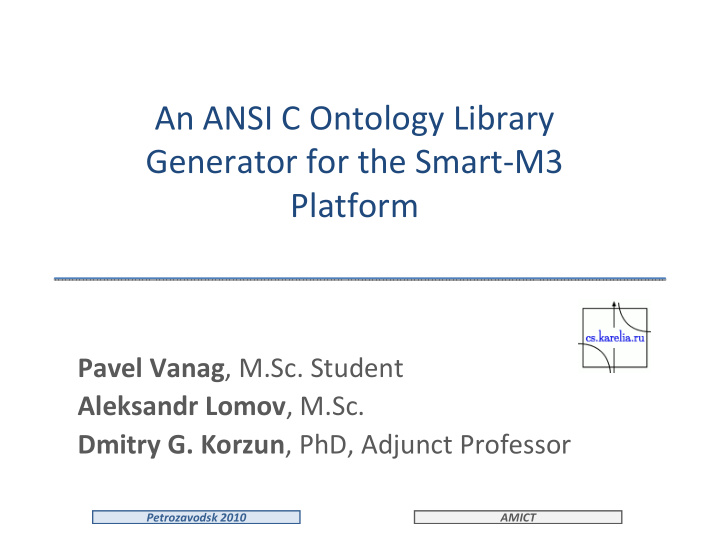



An ANSI C Ontology Library Generator for the Smart ‐ M3 Platform Pavel Vanag , M.Sc. Student Aleksandr Lomov , M.Sc. Dmitry G. Korzun , PhD, Adjunct Professor Petrozavodsk 2010 AMICT
Semantic network and Semantic Web Semantic network Knowledge representation with semantic relations among concepts as a directed or undirected graph Semantic Web Global concept of the WWW development that assumes processing distributed knowledge in accordance with the semantic content Petrozavodsk 2010 AMICT
Smart Spaces Push ‐ based information sharing model rather than specific publish ‐ subscribe model Agents run on ubiquitous devices implementing the push ‐ based model (in terms of Smart Spaces) Smart ‐ M3 (Nokia) is an experimental platform for Smart Spaces Petrozavodsk 2010 AMICT
Examples of applications 1. Meetings and conferences (Ian Oliver, Esko Nuutila, Seppo Torma. Context gathering in meetings: Business processes meet the Agents and the Semantic Web. 2008) 2. Concept «Smart Home» (Kary Främling, Ian Oliver, Jukka Honkola, and Jan Nyman. Smart Spaces for Ubiquitously Smart Buildings. UBICOMM 2009) 3. Social Networks (Sergey Balandin, Ian Oliver, and Sergey Boldyrev . Distributed Architecture of a Professional Social Network on Top of M3 Smart Space Solution Made in PCs and Mobile Devices Friendly Manner. UBICOMM 2009) Petrozavodsk 2010 AMICT
Examples of our development � Hello world � Simple Drinkers � Extended Drinkers � Calendar � Music center Example of music center: Petrozavodsk 2010 AMICT
SmartSlog Project Developing an ANSI C Library Generator for Smart ‐ M3: mapping an OWL ontology description to C code Ontology is a formal description of semantic networks with classes, properties and relations ( OWL , RDF , …) The project is included to the FRUCT program (http://fruct.org/) In collaboration with Nokia Research Center (Helsinki) Petrozavodsk 2010 AMICT
Main advantages In contrast to existing technologies 1. The paradigm Smart Spaces exploits the concept of distributed information sharing with producing new knowledge based on existing information (reasoning) 2. The code generation simplifies developing and testing of agents: they are implemented in high ‐ level terms of the ontology 3. SmartSlog agents can work on embedded and low ‐ performance devices Petrozavodsk 2010 AMICT
Architecture 1. Library (ANSI C) Dependent on ontology part • Independent from ontology part • 2. Generator (Java) 3. Templates (ANSI C with tags) Petrozavodsk 2010 AMICT
Demonstration Drinkers Agent “Timo” publishes the number of liters Timo has drunk. Also it subscribes to SMS from Timo’s wife. Agent “Timo's wife” subscribes to the number of liters for monitoring Timo’s being in the bar When Timo has drunk 5 liters or more his wife sends SMS to the Smart Space notifying that Timo should go home Scenarios: 1. Standard scenario 2. Timo’s agent wouldn’t subscribed to SMS from wife 3. Wrong phone number Petrozavodsk 2010 AMICT
Thank you for your attention Project is published : http://sourceforge.net/projects/smartslog/ Bug report : http://oss.fruct.org/bugzilla/ • Pavel Vanag , M.Sc. Student • Aleksandr Lomov , M.Sc. • Dmitry G. Korzun , PhD, Adjunct Professor Petrozavodsk 2010 AMICT
Recommend
More recommend